International Marketing
VerifiedAdded on 2023/01/05
|14
|4348
|36
AI Summary
Please follow the assignment brief and please cover all the pass-merit and distinction criteria You can use a company of your own choice Thank you
Contribute Materials
Your contribution can guide someone’s learning journey. Share your
documents today.

International
Marketing
Marketing
Secure Best Marks with AI Grader
Need help grading? Try our AI Grader for instant feedback on your assignments.
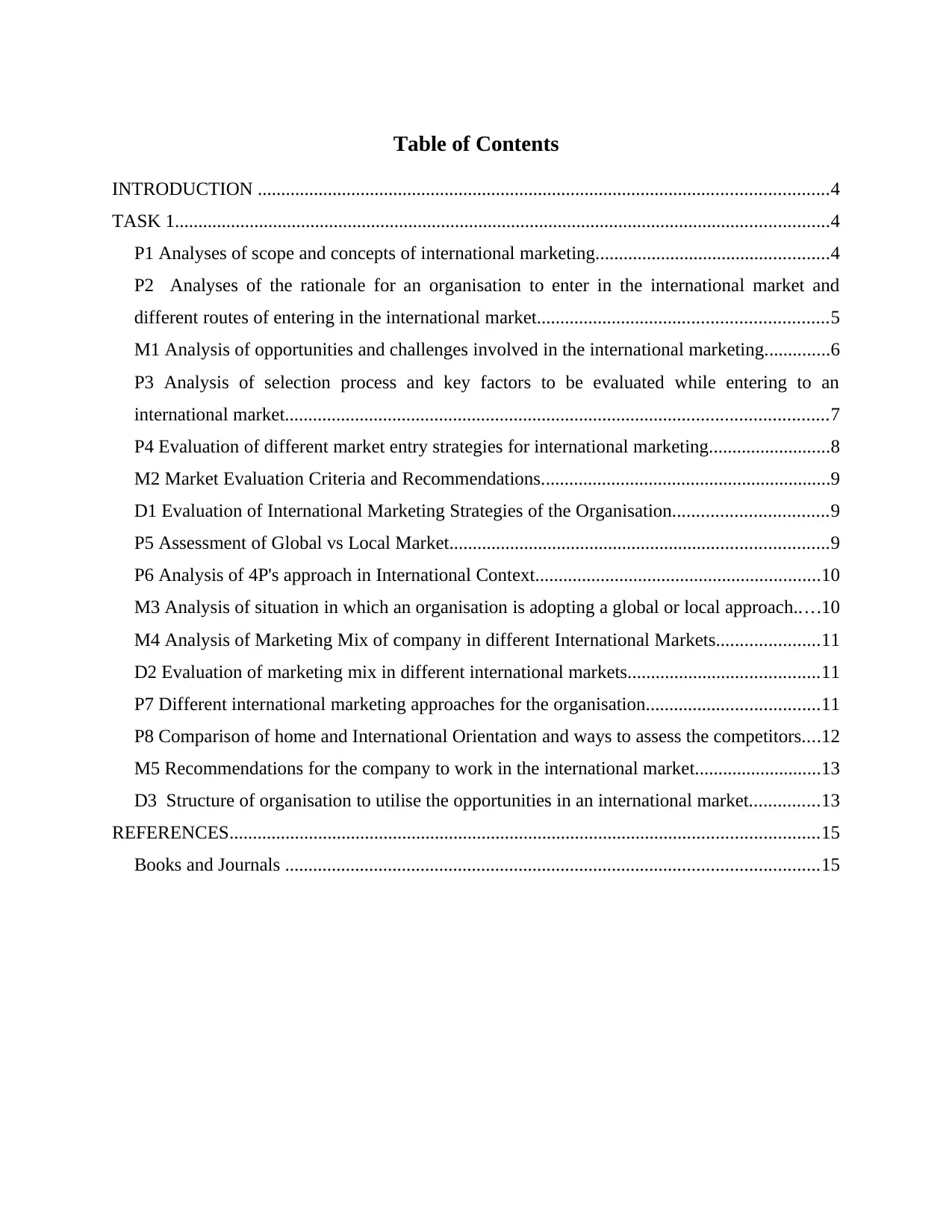
Table of Contents
INTRODUCTION ..........................................................................................................................4
TASK 1............................................................................................................................................4
P1 Analyses of scope and concepts of international marketing..................................................4
P2 Analyses of the rationale for an organisation to enter in the international market and
different routes of entering in the international market..............................................................5
M1 Analysis of opportunities and challenges involved in the international marketing..............6
P3 Analysis of selection process and key factors to be evaluated while entering to an
international market....................................................................................................................7
P4 Evaluation of different market entry strategies for international marketing..........................8
M2 Market Evaluation Criteria and Recommendations..............................................................9
D1 Evaluation of International Marketing Strategies of the Organisation.................................9
P5 Assessment of Global vs Local Market.................................................................................9
P6 Analysis of 4P's approach in International Context.............................................................10
M3 Analysis of situation in which an organisation is adopting a global or local approach.....10
M4 Analysis of Marketing Mix of company in different International Markets......................11
D2 Evaluation of marketing mix in different international markets.........................................11
P7 Different international marketing approaches for the organisation.....................................11
P8 Comparison of home and International Orientation and ways to assess the competitors....12
M5 Recommendations for the company to work in the international market...........................13
D3 Structure of organisation to utilise the opportunities in an international market...............13
REFERENCES..............................................................................................................................15
Books and Journals ..................................................................................................................15
INTRODUCTION ..........................................................................................................................4
TASK 1............................................................................................................................................4
P1 Analyses of scope and concepts of international marketing..................................................4
P2 Analyses of the rationale for an organisation to enter in the international market and
different routes of entering in the international market..............................................................5
M1 Analysis of opportunities and challenges involved in the international marketing..............6
P3 Analysis of selection process and key factors to be evaluated while entering to an
international market....................................................................................................................7
P4 Evaluation of different market entry strategies for international marketing..........................8
M2 Market Evaluation Criteria and Recommendations..............................................................9
D1 Evaluation of International Marketing Strategies of the Organisation.................................9
P5 Assessment of Global vs Local Market.................................................................................9
P6 Analysis of 4P's approach in International Context.............................................................10
M3 Analysis of situation in which an organisation is adopting a global or local approach.....10
M4 Analysis of Marketing Mix of company in different International Markets......................11
D2 Evaluation of marketing mix in different international markets.........................................11
P7 Different international marketing approaches for the organisation.....................................11
P8 Comparison of home and International Orientation and ways to assess the competitors....12
M5 Recommendations for the company to work in the international market...........................13
D3 Structure of organisation to utilise the opportunities in an international market...............13
REFERENCES..............................................................................................................................15
Books and Journals ..................................................................................................................15
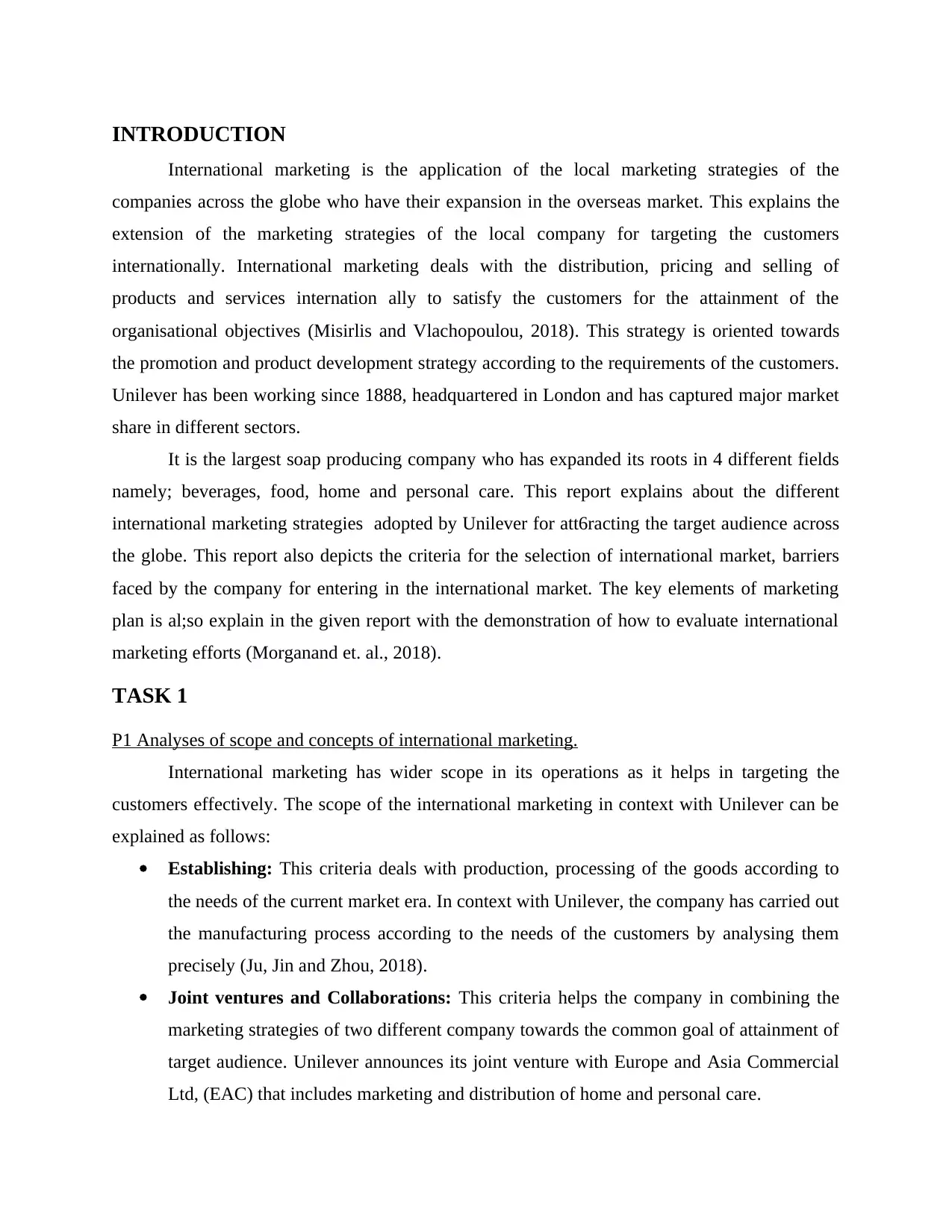
INTRODUCTION
International marketing is the application of the local marketing strategies of the
companies across the globe who have their expansion in the overseas market. This explains the
extension of the marketing strategies of the local company for targeting the customers
internationally. International marketing deals with the distribution, pricing and selling of
products and services internation ally to satisfy the customers for the attainment of the
organisational objectives (Misirlis and Vlachopoulou, 2018). This strategy is oriented towards
the promotion and product development strategy according to the requirements of the customers.
Unilever has been working since 1888, headquartered in London and has captured major market
share in different sectors.
It is the largest soap producing company who has expanded its roots in 4 different fields
namely; beverages, food, home and personal care. This report explains about the different
international marketing strategies adopted by Unilever for att6racting the target audience across
the globe. This report also depicts the criteria for the selection of international market, barriers
faced by the company for entering in the international market. The key elements of marketing
plan is al;so explain in the given report with the demonstration of how to evaluate international
marketing efforts (Morganand et. al., 2018).
TASK 1
P1 Analyses of scope and concepts of international marketing.
International marketing has wider scope in its operations as it helps in targeting the
customers effectively. The scope of the international marketing in context with Unilever can be
explained as follows:
Establishing: This criteria deals with production, processing of the goods according to
the needs of the current market era. In context with Unilever, the company has carried out
the manufacturing process according to the needs of the customers by analysing them
precisely (Ju, Jin and Zhou, 2018).
Joint ventures and Collaborations: This criteria helps the company in combining the
marketing strategies of two different company towards the common goal of attainment of
target audience. Unilever announces its joint venture with Europe and Asia Commercial
Ltd, (EAC) that includes marketing and distribution of home and personal care.
International marketing is the application of the local marketing strategies of the
companies across the globe who have their expansion in the overseas market. This explains the
extension of the marketing strategies of the local company for targeting the customers
internationally. International marketing deals with the distribution, pricing and selling of
products and services internation ally to satisfy the customers for the attainment of the
organisational objectives (Misirlis and Vlachopoulou, 2018). This strategy is oriented towards
the promotion and product development strategy according to the requirements of the customers.
Unilever has been working since 1888, headquartered in London and has captured major market
share in different sectors.
It is the largest soap producing company who has expanded its roots in 4 different fields
namely; beverages, food, home and personal care. This report explains about the different
international marketing strategies adopted by Unilever for att6racting the target audience across
the globe. This report also depicts the criteria for the selection of international market, barriers
faced by the company for entering in the international market. The key elements of marketing
plan is al;so explain in the given report with the demonstration of how to evaluate international
marketing efforts (Morganand et. al., 2018).
TASK 1
P1 Analyses of scope and concepts of international marketing.
International marketing has wider scope in its operations as it helps in targeting the
customers effectively. The scope of the international marketing in context with Unilever can be
explained as follows:
Establishing: This criteria deals with production, processing of the goods according to
the needs of the current market era. In context with Unilever, the company has carried out
the manufacturing process according to the needs of the customers by analysing them
precisely (Ju, Jin and Zhou, 2018).
Joint ventures and Collaborations: This criteria helps the company in combining the
marketing strategies of two different company towards the common goal of attainment of
target audience. Unilever announces its joint venture with Europe and Asia Commercial
Ltd, (EAC) that includes marketing and distribution of home and personal care.
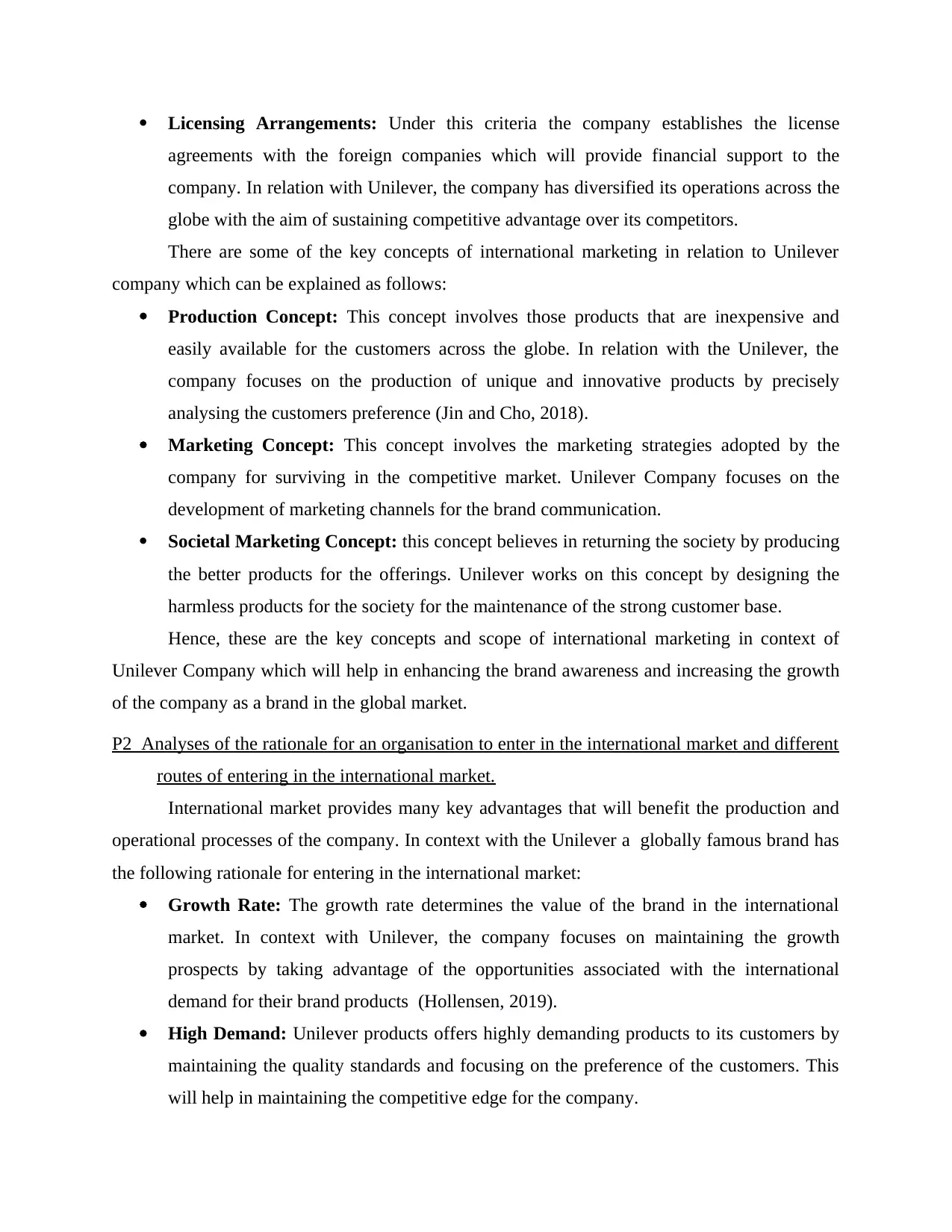
Licensing Arrangements: Under this criteria the company establishes the license
agreements with the foreign companies which will provide financial support to the
company. In relation with Unilever, the company has diversified its operations across the
globe with the aim of sustaining competitive advantage over its competitors.
There are some of the key concepts of international marketing in relation to Unilever
company which can be explained as follows:
Production Concept: This concept involves those products that are inexpensive and
easily available for the customers across the globe. In relation with the Unilever, the
company focuses on the production of unique and innovative products by precisely
analysing the customers preference (Jin and Cho, 2018).
Marketing Concept: This concept involves the marketing strategies adopted by the
company for surviving in the competitive market. Unilever Company focuses on the
development of marketing channels for the brand communication.
Societal Marketing Concept: this concept believes in returning the society by producing
the better products for the offerings. Unilever works on this concept by designing the
harmless products for the society for the maintenance of the strong customer base.
Hence, these are the key concepts and scope of international marketing in context of
Unilever Company which will help in enhancing the brand awareness and increasing the growth
of the company as a brand in the global market.
P2 Analyses of the rationale for an organisation to enter in the international market and different
routes of entering in the international market.
International market provides many key advantages that will benefit the production and
operational processes of the company. In context with the Unilever a globally famous brand has
the following rationale for entering in the international market:
Growth Rate: The growth rate determines the value of the brand in the international
market. In context with Unilever, the company focuses on maintaining the growth
prospects by taking advantage of the opportunities associated with the international
demand for their brand products (Hollensen, 2019).
High Demand: Unilever products offers highly demanding products to its customers by
maintaining the quality standards and focusing on the preference of the customers. This
will help in maintaining the competitive edge for the company.
agreements with the foreign companies which will provide financial support to the
company. In relation with Unilever, the company has diversified its operations across the
globe with the aim of sustaining competitive advantage over its competitors.
There are some of the key concepts of international marketing in relation to Unilever
company which can be explained as follows:
Production Concept: This concept involves those products that are inexpensive and
easily available for the customers across the globe. In relation with the Unilever, the
company focuses on the production of unique and innovative products by precisely
analysing the customers preference (Jin and Cho, 2018).
Marketing Concept: This concept involves the marketing strategies adopted by the
company for surviving in the competitive market. Unilever Company focuses on the
development of marketing channels for the brand communication.
Societal Marketing Concept: this concept believes in returning the society by producing
the better products for the offerings. Unilever works on this concept by designing the
harmless products for the society for the maintenance of the strong customer base.
Hence, these are the key concepts and scope of international marketing in context of
Unilever Company which will help in enhancing the brand awareness and increasing the growth
of the company as a brand in the global market.
P2 Analyses of the rationale for an organisation to enter in the international market and different
routes of entering in the international market.
International market provides many key advantages that will benefit the production and
operational processes of the company. In context with the Unilever a globally famous brand has
the following rationale for entering in the international market:
Growth Rate: The growth rate determines the value of the brand in the international
market. In context with Unilever, the company focuses on maintaining the growth
prospects by taking advantage of the opportunities associated with the international
demand for their brand products (Hollensen, 2019).
High Demand: Unilever products offers highly demanding products to its customers by
maintaining the quality standards and focusing on the preference of the customers. This
will help in maintaining the competitive edge for the company.
Paraphrase This Document
Need a fresh take? Get an instant paraphrase of this document with our AI Paraphraser
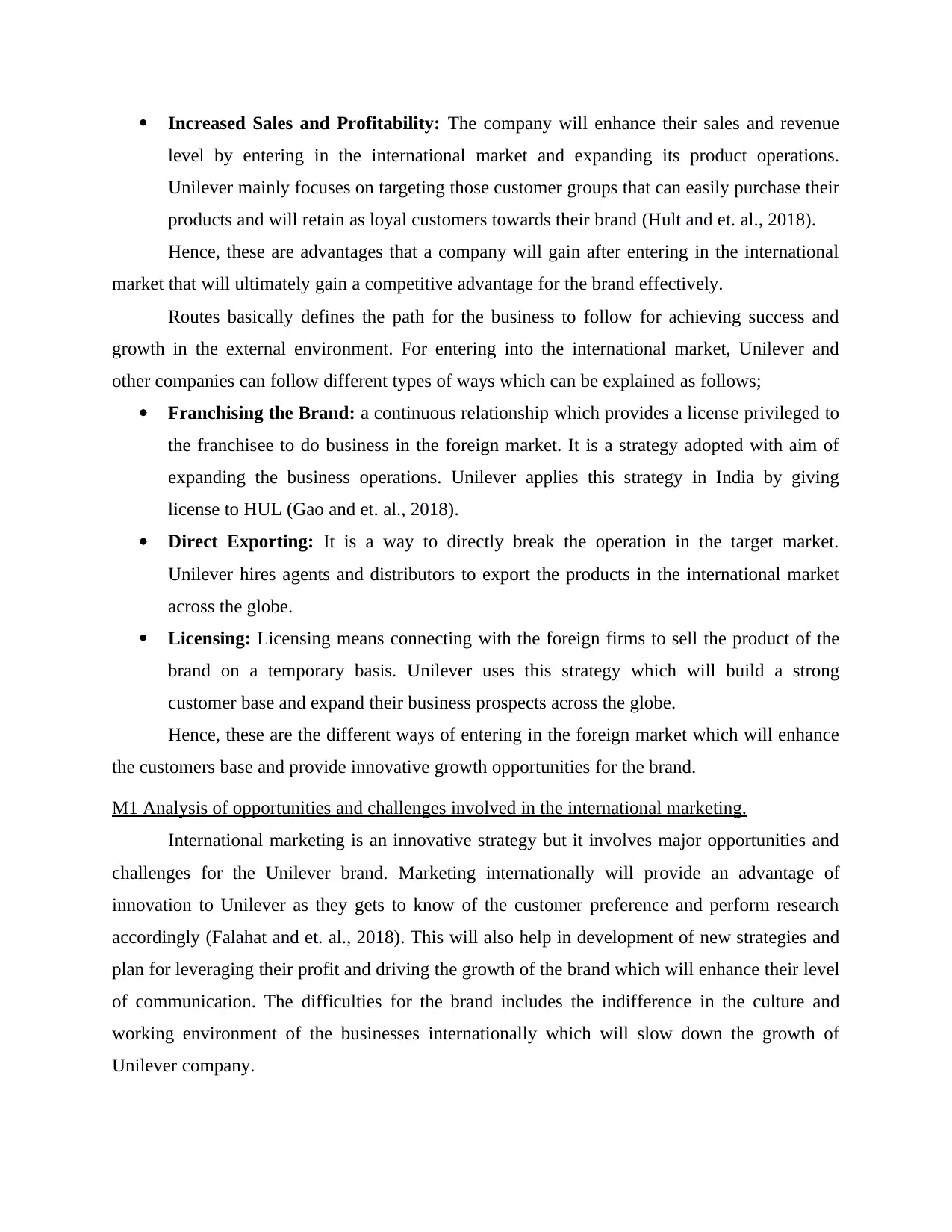
Increased Sales and Profitability: The company will enhance their sales and revenue
level by entering in the international market and expanding its product operations.
Unilever mainly focuses on targeting those customer groups that can easily purchase their
products and will retain as loyal customers towards their brand (Hult and et. al., 2018).
Hence, these are advantages that a company will gain after entering in the international
market that will ultimately gain a competitive advantage for the brand effectively.
Routes basically defines the path for the business to follow for achieving success and
growth in the external environment. For entering into the international market, Unilever and
other companies can follow different types of ways which can be explained as follows;
Franchising the Brand: a continuous relationship which provides a license privileged to
the franchisee to do business in the foreign market. It is a strategy adopted with aim of
expanding the business operations. Unilever applies this strategy in India by giving
license to HUL (Gao and et. al., 2018).
Direct Exporting: It is a way to directly break the operation in the target market.
Unilever hires agents and distributors to export the products in the international market
across the globe.
Licensing: Licensing means connecting with the foreign firms to sell the product of the
brand on a temporary basis. Unilever uses this strategy which will build a strong
customer base and expand their business prospects across the globe.
Hence, these are the different ways of entering in the foreign market which will enhance
the customers base and provide innovative growth opportunities for the brand.
M1 Analysis of opportunities and challenges involved in the international marketing.
International marketing is an innovative strategy but it involves major opportunities and
challenges for the Unilever brand. Marketing internationally will provide an advantage of
innovation to Unilever as they gets to know of the customer preference and perform research
accordingly (Falahat and et. al., 2018). This will also help in development of new strategies and
plan for leveraging their profit and driving the growth of the brand which will enhance their level
of communication. The difficulties for the brand includes the indifference in the culture and
working environment of the businesses internationally which will slow down the growth of
Unilever company.
level by entering in the international market and expanding its product operations.
Unilever mainly focuses on targeting those customer groups that can easily purchase their
products and will retain as loyal customers towards their brand (Hult and et. al., 2018).
Hence, these are advantages that a company will gain after entering in the international
market that will ultimately gain a competitive advantage for the brand effectively.
Routes basically defines the path for the business to follow for achieving success and
growth in the external environment. For entering into the international market, Unilever and
other companies can follow different types of ways which can be explained as follows;
Franchising the Brand: a continuous relationship which provides a license privileged to
the franchisee to do business in the foreign market. It is a strategy adopted with aim of
expanding the business operations. Unilever applies this strategy in India by giving
license to HUL (Gao and et. al., 2018).
Direct Exporting: It is a way to directly break the operation in the target market.
Unilever hires agents and distributors to export the products in the international market
across the globe.
Licensing: Licensing means connecting with the foreign firms to sell the product of the
brand on a temporary basis. Unilever uses this strategy which will build a strong
customer base and expand their business prospects across the globe.
Hence, these are the different ways of entering in the foreign market which will enhance
the customers base and provide innovative growth opportunities for the brand.
M1 Analysis of opportunities and challenges involved in the international marketing.
International marketing is an innovative strategy but it involves major opportunities and
challenges for the Unilever brand. Marketing internationally will provide an advantage of
innovation to Unilever as they gets to know of the customer preference and perform research
accordingly (Falahat and et. al., 2018). This will also help in development of new strategies and
plan for leveraging their profit and driving the growth of the brand which will enhance their level
of communication. The difficulties for the brand includes the indifference in the culture and
working environment of the businesses internationally which will slow down the growth of
Unilever company.

TASK 2
P3 Analysis of selection process and key factors to be evaluated while entering to an
international market.
The company must analyse some of the parameters while entering the international
market for the purpose of expanding their brand value across the globe. These parameters can be
explained as follows:
Government Policies: The company must analyse the current government policies
prevailing the international market in which they wish to enter. In context with Unilever,
the company have precisely analysed the India's government policies before expanding
and franchising the business as HUL.
International Environment: The company must analyse the international environment
of the market in which they wish to enter which will creates a competitive edge and
provides them knowledge about the dynamic unpredictable environment.
Firm's Resources: Before entering into an international market, the company must
analyse the firm's resources which will help to develop strategies for the fierce
competition prevailing in the market. Unilever have analysed its resources and
capabilities of their workforce effectively to ensure proper development of innovative
products in the international market.
The company have to follow a procedure for the selection of market at the international level.
This process is based on the evaluation of different markets according to the requirements of the
company which can be explained as follows:
International Marketing Objectives: This step depicts the selection of the export
marketing objectives of the organisation. Unilever have developed their objective of
becoming a globally famous brand with the help of expansion (De Mooij, 2018).
Parameters for Selection: For proper evaluation and selection of the market, the
company must analyse the factors like the market situation and nature of competition
which will help in defining clear objectives for the company.
Preliminary Screening: This involves eliminating the factors which are not potential for
the company's requirement. These parameters include per capita income, structure of
economy and many more.
P3 Analysis of selection process and key factors to be evaluated while entering to an
international market.
The company must analyse some of the parameters while entering the international
market for the purpose of expanding their brand value across the globe. These parameters can be
explained as follows:
Government Policies: The company must analyse the current government policies
prevailing the international market in which they wish to enter. In context with Unilever,
the company have precisely analysed the India's government policies before expanding
and franchising the business as HUL.
International Environment: The company must analyse the international environment
of the market in which they wish to enter which will creates a competitive edge and
provides them knowledge about the dynamic unpredictable environment.
Firm's Resources: Before entering into an international market, the company must
analyse the firm's resources which will help to develop strategies for the fierce
competition prevailing in the market. Unilever have analysed its resources and
capabilities of their workforce effectively to ensure proper development of innovative
products in the international market.
The company have to follow a procedure for the selection of market at the international level.
This process is based on the evaluation of different markets according to the requirements of the
company which can be explained as follows:
International Marketing Objectives: This step depicts the selection of the export
marketing objectives of the organisation. Unilever have developed their objective of
becoming a globally famous brand with the help of expansion (De Mooij, 2018).
Parameters for Selection: For proper evaluation and selection of the market, the
company must analyse the factors like the market situation and nature of competition
which will help in defining clear objectives for the company.
Preliminary Screening: This involves eliminating the factors which are not potential for
the company's requirement. These parameters include per capita income, structure of
economy and many more.
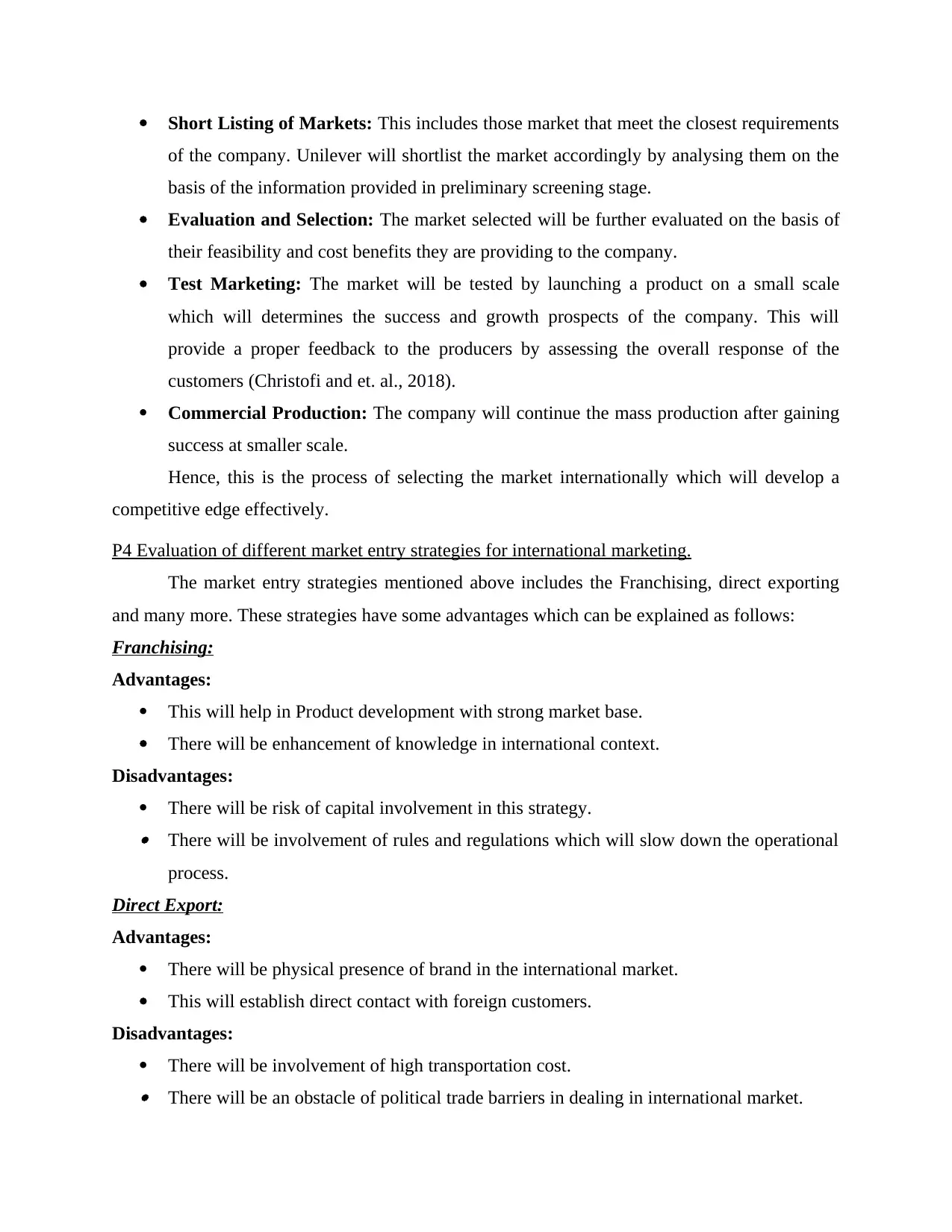
Short Listing of Markets: This includes those market that meet the closest requirements
of the company. Unilever will shortlist the market accordingly by analysing them on the
basis of the information provided in preliminary screening stage.
Evaluation and Selection: The market selected will be further evaluated on the basis of
their feasibility and cost benefits they are providing to the company.
Test Marketing: The market will be tested by launching a product on a small scale
which will determines the success and growth prospects of the company. This will
provide a proper feedback to the producers by assessing the overall response of the
customers (Christofi and et. al., 2018).
Commercial Production: The company will continue the mass production after gaining
success at smaller scale.
Hence, this is the process of selecting the market internationally which will develop a
competitive edge effectively.
P4 Evaluation of different market entry strategies for international marketing.
The market entry strategies mentioned above includes the Franchising, direct exporting
and many more. These strategies have some advantages which can be explained as follows:
Franchising:
Advantages:
This will help in Product development with strong market base.
There will be enhancement of knowledge in international context.
Disadvantages:
There will be risk of capital involvement in this strategy. There will be involvement of rules and regulations which will slow down the operational
process.
Direct Export:
Advantages:
There will be physical presence of brand in the international market.
This will establish direct contact with foreign customers.
Disadvantages:
There will be involvement of high transportation cost. There will be an obstacle of political trade barriers in dealing in international market.
of the company. Unilever will shortlist the market accordingly by analysing them on the
basis of the information provided in preliminary screening stage.
Evaluation and Selection: The market selected will be further evaluated on the basis of
their feasibility and cost benefits they are providing to the company.
Test Marketing: The market will be tested by launching a product on a small scale
which will determines the success and growth prospects of the company. This will
provide a proper feedback to the producers by assessing the overall response of the
customers (Christofi and et. al., 2018).
Commercial Production: The company will continue the mass production after gaining
success at smaller scale.
Hence, this is the process of selecting the market internationally which will develop a
competitive edge effectively.
P4 Evaluation of different market entry strategies for international marketing.
The market entry strategies mentioned above includes the Franchising, direct exporting
and many more. These strategies have some advantages which can be explained as follows:
Franchising:
Advantages:
This will help in Product development with strong market base.
There will be enhancement of knowledge in international context.
Disadvantages:
There will be risk of capital involvement in this strategy. There will be involvement of rules and regulations which will slow down the operational
process.
Direct Export:
Advantages:
There will be physical presence of brand in the international market.
This will establish direct contact with foreign customers.
Disadvantages:
There will be involvement of high transportation cost. There will be an obstacle of political trade barriers in dealing in international market.
Secure Best Marks with AI Grader
Need help grading? Try our AI Grader for instant feedback on your assignments.
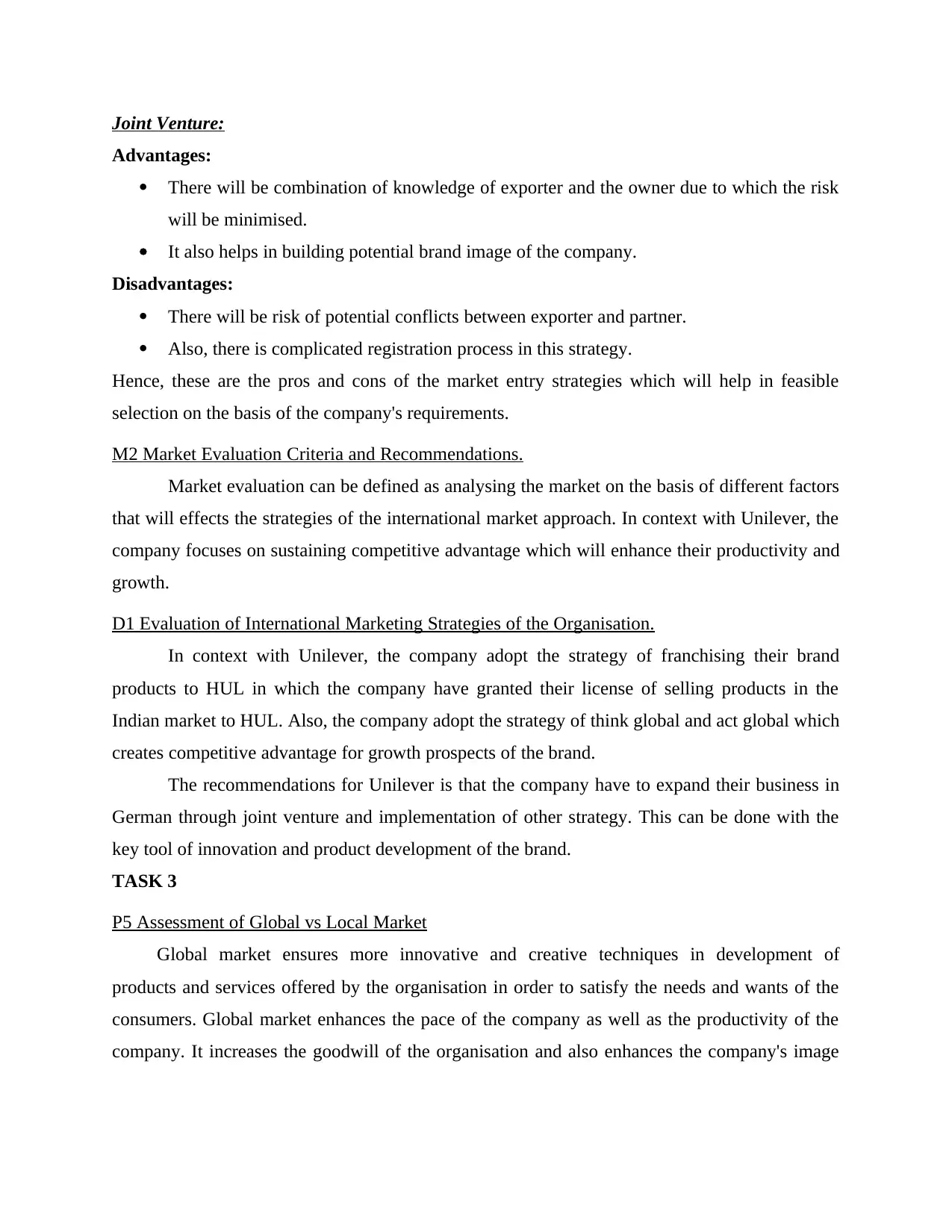
Joint Venture:
Advantages:
There will be combination of knowledge of exporter and the owner due to which the risk
will be minimised.
It also helps in building potential brand image of the company.
Disadvantages:
There will be risk of potential conflicts between exporter and partner.
Also, there is complicated registration process in this strategy.
Hence, these are the pros and cons of the market entry strategies which will help in feasible
selection on the basis of the company's requirements.
M2 Market Evaluation Criteria and Recommendations.
Market evaluation can be defined as analysing the market on the basis of different factors
that will effects the strategies of the international market approach. In context with Unilever, the
company focuses on sustaining competitive advantage which will enhance their productivity and
growth.
D1 Evaluation of International Marketing Strategies of the Organisation.
In context with Unilever, the company adopt the strategy of franchising their brand
products to HUL in which the company have granted their license of selling products in the
Indian market to HUL. Also, the company adopt the strategy of think global and act global which
creates competitive advantage for growth prospects of the brand.
The recommendations for Unilever is that the company have to expand their business in
German through joint venture and implementation of other strategy. This can be done with the
key tool of innovation and product development of the brand.
TASK 3
P5 Assessment of Global vs Local Market
Global market ensures more innovative and creative techniques in development of
products and services offered by the organisation in order to satisfy the needs and wants of the
consumers. Global market enhances the pace of the company as well as the productivity of the
company. It increases the goodwill of the organisation and also enhances the company's image
Advantages:
There will be combination of knowledge of exporter and the owner due to which the risk
will be minimised.
It also helps in building potential brand image of the company.
Disadvantages:
There will be risk of potential conflicts between exporter and partner.
Also, there is complicated registration process in this strategy.
Hence, these are the pros and cons of the market entry strategies which will help in feasible
selection on the basis of the company's requirements.
M2 Market Evaluation Criteria and Recommendations.
Market evaluation can be defined as analysing the market on the basis of different factors
that will effects the strategies of the international market approach. In context with Unilever, the
company focuses on sustaining competitive advantage which will enhance their productivity and
growth.
D1 Evaluation of International Marketing Strategies of the Organisation.
In context with Unilever, the company adopt the strategy of franchising their brand
products to HUL in which the company have granted their license of selling products in the
Indian market to HUL. Also, the company adopt the strategy of think global and act global which
creates competitive advantage for growth prospects of the brand.
The recommendations for Unilever is that the company have to expand their business in
German through joint venture and implementation of other strategy. This can be done with the
key tool of innovation and product development of the brand.
TASK 3
P5 Assessment of Global vs Local Market
Global market ensures more innovative and creative techniques in development of
products and services offered by the organisation in order to satisfy the needs and wants of the
consumers. Global market enhances the pace of the company as well as the productivity of the
company. It increases the goodwill of the organisation and also enhances the company's image

and overall brand value. Large scale organisations usually opt for global market as it helps them
to expand their market and gain excessive profit through it (Cavusgil and et. al., 2018).
In order to deal in Global markets, it very essential to utilise advanced technology. Advanced
technology helps the company in effective utilisation of resources within minimum duration.
In Local market, products and services are catered to less number of customers in
comparison to the global market which in turn limits the growth and development of the
company which ultimately effects the profit generation of the company. Due to restricted
resources, the company that is catering to Local market cannot expand its services in the
international market. The company is only able to satisfy the wants of limited consumers and
cannot grow beyond that.
P6 Analysis of 4P's approach in International Context
Product, Pricing, Promotional and Distribution Approach Differ
The above mentioned strategies are referred to Market Strategies. These strategies are
implemented by the organisation to gain advantage in the market environment. These strategies
allows the firm to differentiate their products and services from their competitors prevailing in
the market. In order to attract a larger customer base an organisation should focus on building
good pricing, promotion and distribution strategies. Due to fluctuations in the economic
environment, an organisation should be able to adapt to the changes and fix the pricing policies
considering the same. Promotion Strategy helps the organisation to attract more customers and
capture more market by making the products more popular among the customers. The
distribution channels are responsible for providing the end product to the consumers through a
series of supply chains. It is very essential to choose the right strategy at the right time in order to
gain competitive advantages and benefits in the market (Cateora and et. al., 2020).
M3 Analysis of situation in which an organisation is adopting a global or local approach.
In context with Unilever, the company is adopting the local approach when the company
wants to expand their business operations and analyse the future growth prospects of the
company. If the company is adopting the global approach then they have the advantage of single
market framework which will reduce their overall operational cost and there will be
implementation of standardised strategy at a global level.
to expand their market and gain excessive profit through it (Cavusgil and et. al., 2018).
In order to deal in Global markets, it very essential to utilise advanced technology. Advanced
technology helps the company in effective utilisation of resources within minimum duration.
In Local market, products and services are catered to less number of customers in
comparison to the global market which in turn limits the growth and development of the
company which ultimately effects the profit generation of the company. Due to restricted
resources, the company that is catering to Local market cannot expand its services in the
international market. The company is only able to satisfy the wants of limited consumers and
cannot grow beyond that.
P6 Analysis of 4P's approach in International Context
Product, Pricing, Promotional and Distribution Approach Differ
The above mentioned strategies are referred to Market Strategies. These strategies are
implemented by the organisation to gain advantage in the market environment. These strategies
allows the firm to differentiate their products and services from their competitors prevailing in
the market. In order to attract a larger customer base an organisation should focus on building
good pricing, promotion and distribution strategies. Due to fluctuations in the economic
environment, an organisation should be able to adapt to the changes and fix the pricing policies
considering the same. Promotion Strategy helps the organisation to attract more customers and
capture more market by making the products more popular among the customers. The
distribution channels are responsible for providing the end product to the consumers through a
series of supply chains. It is very essential to choose the right strategy at the right time in order to
gain competitive advantages and benefits in the market (Cateora and et. al., 2020).
M3 Analysis of situation in which an organisation is adopting a global or local approach.
In context with Unilever, the company is adopting the local approach when the company
wants to expand their business operations and analyse the future growth prospects of the
company. If the company is adopting the global approach then they have the advantage of single
market framework which will reduce their overall operational cost and there will be
implementation of standardised strategy at a global level.
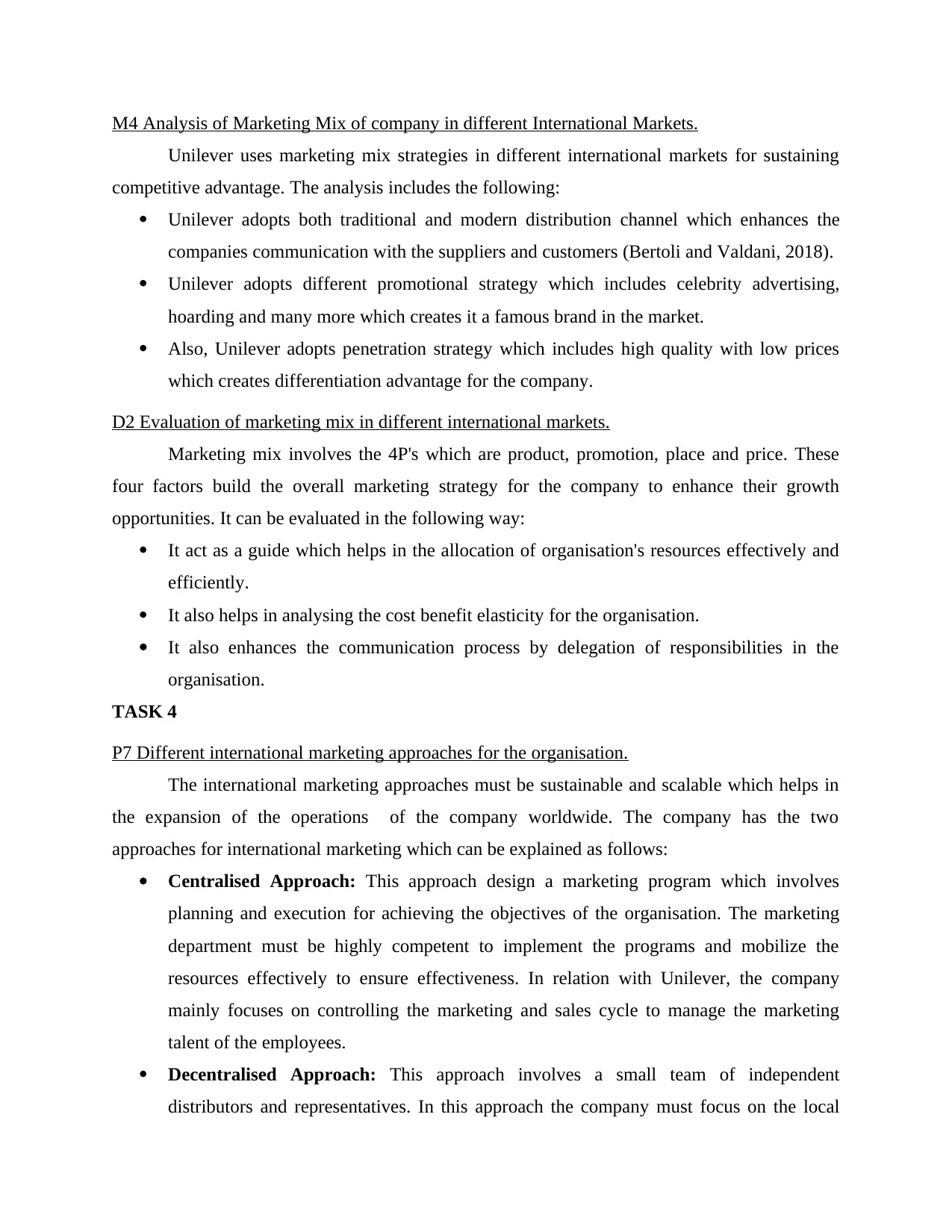
M4 Analysis of Marketing Mix of company in different International Markets.
Unilever uses marketing mix strategies in different international markets for sustaining
competitive advantage. The analysis includes the following:
Unilever adopts both traditional and modern distribution channel which enhances the
companies communication with the suppliers and customers (Bertoli and Valdani, 2018).
Unilever adopts different promotional strategy which includes celebrity advertising,
hoarding and many more which creates it a famous brand in the market.
Also, Unilever adopts penetration strategy which includes high quality with low prices
which creates differentiation advantage for the company.
D2 Evaluation of marketing mix in different international markets.
Marketing mix involves the 4P's which are product, promotion, place and price. These
four factors build the overall marketing strategy for the company to enhance their growth
opportunities. It can be evaluated in the following way:
It act as a guide which helps in the allocation of organisation's resources effectively and
efficiently.
It also helps in analysing the cost benefit elasticity for the organisation.
It also enhances the communication process by delegation of responsibilities in the
organisation.
TASK 4
P7 Different international marketing approaches for the organisation.
The international marketing approaches must be sustainable and scalable which helps in
the expansion of the operations of the company worldwide. The company has the two
approaches for international marketing which can be explained as follows:
Centralised Approach: This approach design a marketing program which involves
planning and execution for achieving the objectives of the organisation. The marketing
department must be highly competent to implement the programs and mobilize the
resources effectively to ensure effectiveness. In relation with Unilever, the company
mainly focuses on controlling the marketing and sales cycle to manage the marketing
talent of the employees.
Decentralised Approach: This approach involves a small team of independent
distributors and representatives. In this approach the company must focus on the local
Unilever uses marketing mix strategies in different international markets for sustaining
competitive advantage. The analysis includes the following:
Unilever adopts both traditional and modern distribution channel which enhances the
companies communication with the suppliers and customers (Bertoli and Valdani, 2018).
Unilever adopts different promotional strategy which includes celebrity advertising,
hoarding and many more which creates it a famous brand in the market.
Also, Unilever adopts penetration strategy which includes high quality with low prices
which creates differentiation advantage for the company.
D2 Evaluation of marketing mix in different international markets.
Marketing mix involves the 4P's which are product, promotion, place and price. These
four factors build the overall marketing strategy for the company to enhance their growth
opportunities. It can be evaluated in the following way:
It act as a guide which helps in the allocation of organisation's resources effectively and
efficiently.
It also helps in analysing the cost benefit elasticity for the organisation.
It also enhances the communication process by delegation of responsibilities in the
organisation.
TASK 4
P7 Different international marketing approaches for the organisation.
The international marketing approaches must be sustainable and scalable which helps in
the expansion of the operations of the company worldwide. The company has the two
approaches for international marketing which can be explained as follows:
Centralised Approach: This approach design a marketing program which involves
planning and execution for achieving the objectives of the organisation. The marketing
department must be highly competent to implement the programs and mobilize the
resources effectively to ensure effectiveness. In relation with Unilever, the company
mainly focuses on controlling the marketing and sales cycle to manage the marketing
talent of the employees.
Decentralised Approach: This approach involves a small team of independent
distributors and representatives. In this approach the company must focus on the local
Paraphrase This Document
Need a fresh take? Get an instant paraphrase of this document with our AI Paraphraser
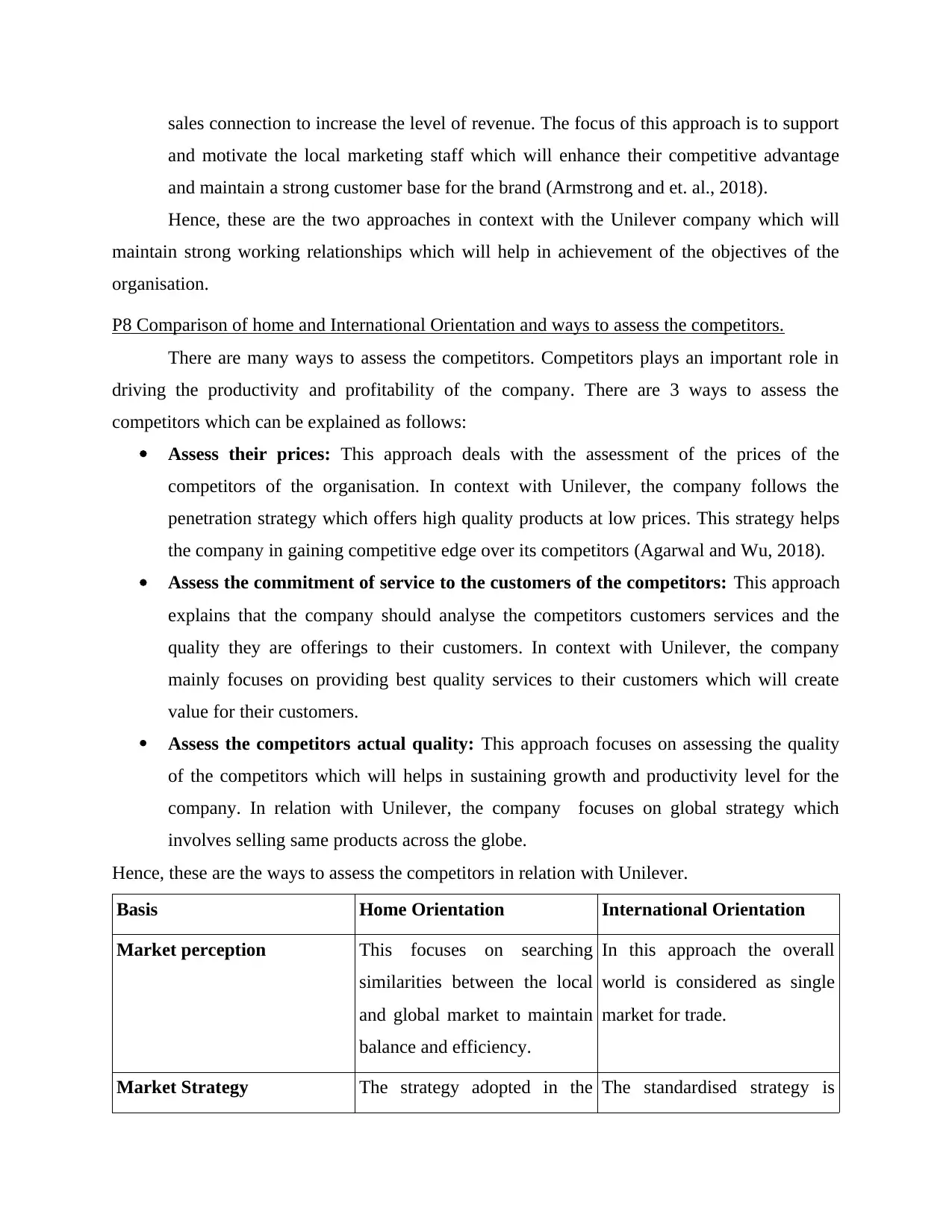
sales connection to increase the level of revenue. The focus of this approach is to support
and motivate the local marketing staff which will enhance their competitive advantage
and maintain a strong customer base for the brand (Armstrong and et. al., 2018).
Hence, these are the two approaches in context with the Unilever company which will
maintain strong working relationships which will help in achievement of the objectives of the
organisation.
P8 Comparison of home and International Orientation and ways to assess the competitors.
There are many ways to assess the competitors. Competitors plays an important role in
driving the productivity and profitability of the company. There are 3 ways to assess the
competitors which can be explained as follows:
Assess their prices: This approach deals with the assessment of the prices of the
competitors of the organisation. In context with Unilever, the company follows the
penetration strategy which offers high quality products at low prices. This strategy helps
the company in gaining competitive edge over its competitors (Agarwal and Wu, 2018).
Assess the commitment of service to the customers of the competitors: This approach
explains that the company should analyse the competitors customers services and the
quality they are offerings to their customers. In context with Unilever, the company
mainly focuses on providing best quality services to their customers which will create
value for their customers.
Assess the competitors actual quality: This approach focuses on assessing the quality
of the competitors which will helps in sustaining growth and productivity level for the
company. In relation with Unilever, the company focuses on global strategy which
involves selling same products across the globe.
Hence, these are the ways to assess the competitors in relation with Unilever.
Basis Home Orientation International Orientation
Market perception This focuses on searching
similarities between the local
and global market to maintain
balance and efficiency.
In this approach the overall
world is considered as single
market for trade.
Market Strategy The strategy adopted in the The standardised strategy is
and motivate the local marketing staff which will enhance their competitive advantage
and maintain a strong customer base for the brand (Armstrong and et. al., 2018).
Hence, these are the two approaches in context with the Unilever company which will
maintain strong working relationships which will help in achievement of the objectives of the
organisation.
P8 Comparison of home and International Orientation and ways to assess the competitors.
There are many ways to assess the competitors. Competitors plays an important role in
driving the productivity and profitability of the company. There are 3 ways to assess the
competitors which can be explained as follows:
Assess their prices: This approach deals with the assessment of the prices of the
competitors of the organisation. In context with Unilever, the company follows the
penetration strategy which offers high quality products at low prices. This strategy helps
the company in gaining competitive edge over its competitors (Agarwal and Wu, 2018).
Assess the commitment of service to the customers of the competitors: This approach
explains that the company should analyse the competitors customers services and the
quality they are offerings to their customers. In context with Unilever, the company
mainly focuses on providing best quality services to their customers which will create
value for their customers.
Assess the competitors actual quality: This approach focuses on assessing the quality
of the competitors which will helps in sustaining growth and productivity level for the
company. In relation with Unilever, the company focuses on global strategy which
involves selling same products across the globe.
Hence, these are the ways to assess the competitors in relation with Unilever.
Basis Home Orientation International Orientation
Market perception This focuses on searching
similarities between the local
and global market to maintain
balance and efficiency.
In this approach the overall
world is considered as single
market for trade.
Market Strategy The strategy adopted in the The standardised strategy is
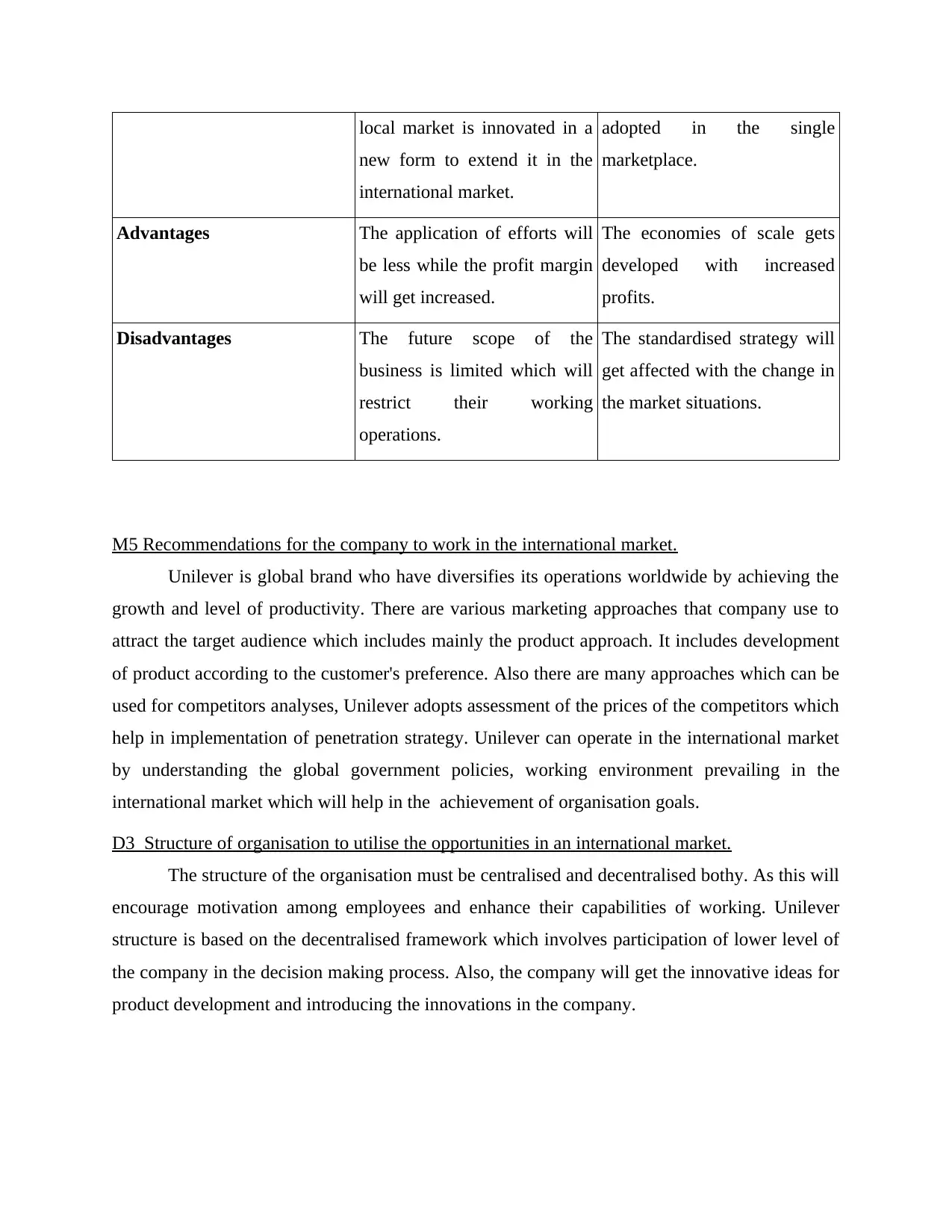
local market is innovated in a
new form to extend it in the
international market.
adopted in the single
marketplace.
Advantages The application of efforts will
be less while the profit margin
will get increased.
The economies of scale gets
developed with increased
profits.
Disadvantages The future scope of the
business is limited which will
restrict their working
operations.
The standardised strategy will
get affected with the change in
the market situations.
M5 Recommendations for the company to work in the international market.
Unilever is global brand who have diversifies its operations worldwide by achieving the
growth and level of productivity. There are various marketing approaches that company use to
attract the target audience which includes mainly the product approach. It includes development
of product according to the customer's preference. Also there are many approaches which can be
used for competitors analyses, Unilever adopts assessment of the prices of the competitors which
help in implementation of penetration strategy. Unilever can operate in the international market
by understanding the global government policies, working environment prevailing in the
international market which will help in the achievement of organisation goals.
D3 Structure of organisation to utilise the opportunities in an international market.
The structure of the organisation must be centralised and decentralised bothy. As this will
encourage motivation among employees and enhance their capabilities of working. Unilever
structure is based on the decentralised framework which involves participation of lower level of
the company in the decision making process. Also, the company will get the innovative ideas for
product development and introducing the innovations in the company.
new form to extend it in the
international market.
adopted in the single
marketplace.
Advantages The application of efforts will
be less while the profit margin
will get increased.
The economies of scale gets
developed with increased
profits.
Disadvantages The future scope of the
business is limited which will
restrict their working
operations.
The standardised strategy will
get affected with the change in
the market situations.
M5 Recommendations for the company to work in the international market.
Unilever is global brand who have diversifies its operations worldwide by achieving the
growth and level of productivity. There are various marketing approaches that company use to
attract the target audience which includes mainly the product approach. It includes development
of product according to the customer's preference. Also there are many approaches which can be
used for competitors analyses, Unilever adopts assessment of the prices of the competitors which
help in implementation of penetration strategy. Unilever can operate in the international market
by understanding the global government policies, working environment prevailing in the
international market which will help in the achievement of organisation goals.
D3 Structure of organisation to utilise the opportunities in an international market.
The structure of the organisation must be centralised and decentralised bothy. As this will
encourage motivation among employees and enhance their capabilities of working. Unilever
structure is based on the decentralised framework which involves participation of lower level of
the company in the decision making process. Also, the company will get the innovative ideas for
product development and introducing the innovations in the company.
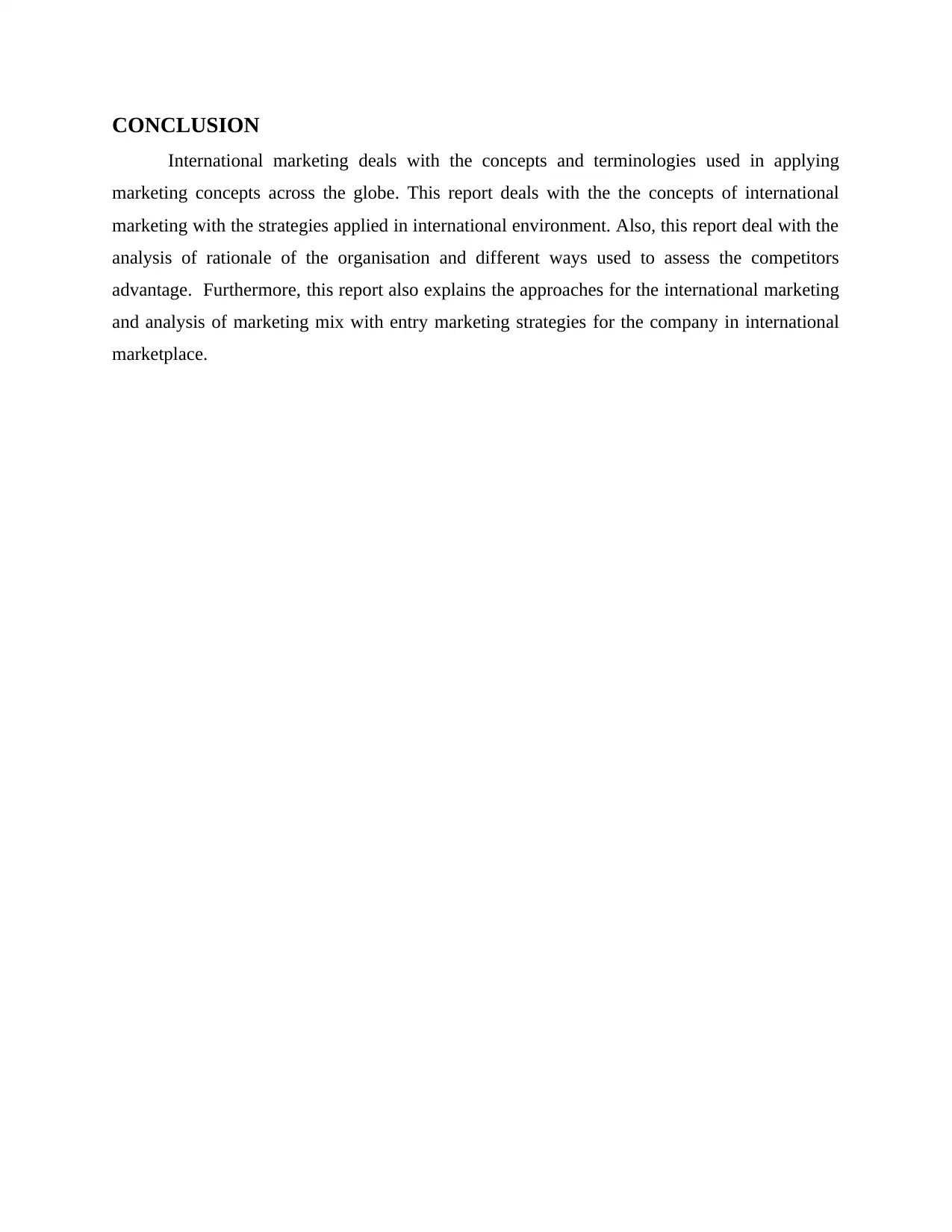
CONCLUSION
International marketing deals with the concepts and terminologies used in applying
marketing concepts across the globe. This report deals with the the concepts of international
marketing with the strategies applied in international environment. Also, this report deal with the
analysis of rationale of the organisation and different ways used to assess the competitors
advantage. Furthermore, this report also explains the approaches for the international marketing
and analysis of marketing mix with entry marketing strategies for the company in international
marketplace.
International marketing deals with the concepts and terminologies used in applying
marketing concepts across the globe. This report deals with the the concepts of international
marketing with the strategies applied in international environment. Also, this report deal with the
analysis of rationale of the organisation and different ways used to assess the competitors
advantage. Furthermore, this report also explains the approaches for the international marketing
and analysis of marketing mix with entry marketing strategies for the company in international
marketplace.
Secure Best Marks with AI Grader
Need help grading? Try our AI Grader for instant feedback on your assignments.
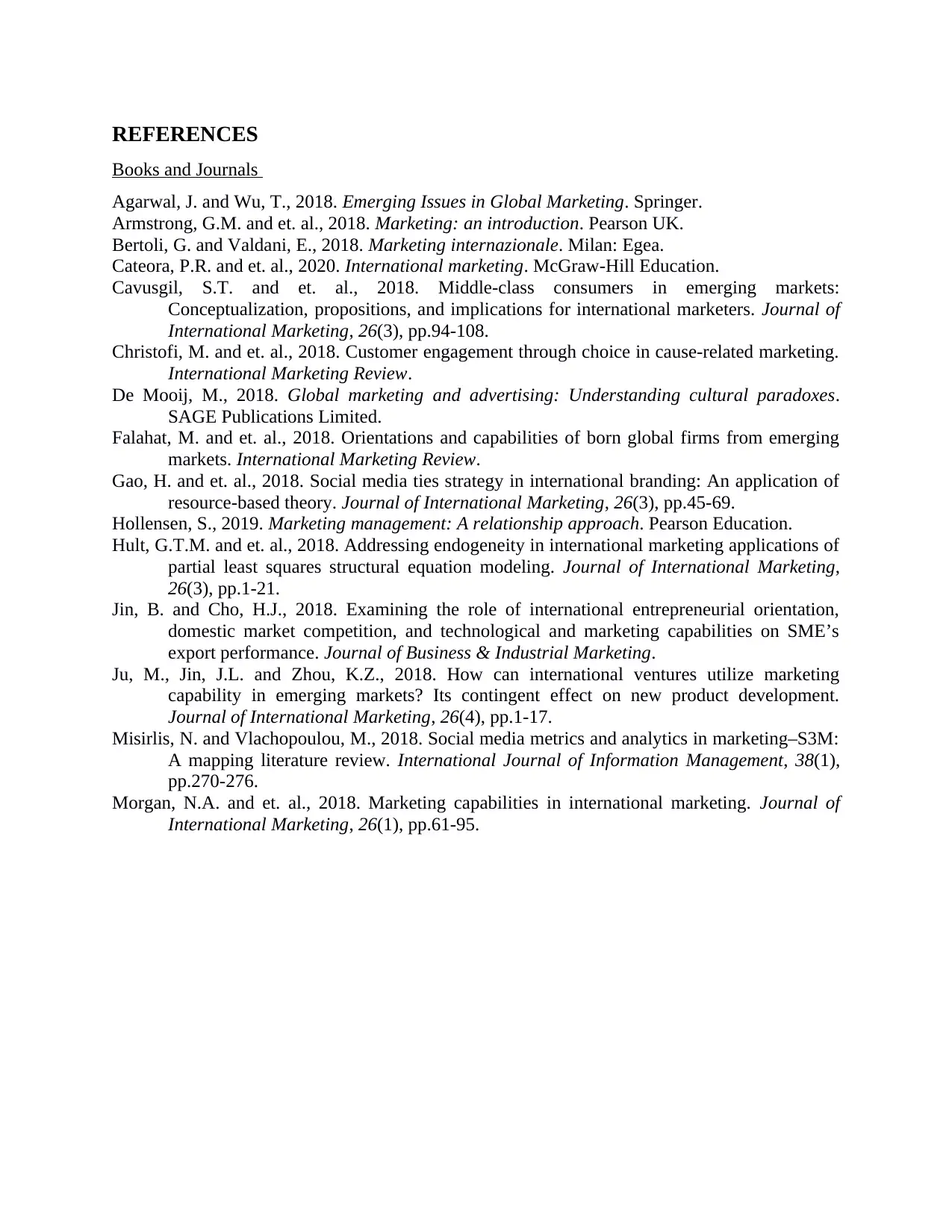
REFERENCES
Books and Journals
Agarwal, J. and Wu, T., 2018. Emerging Issues in Global Marketing. Springer.
Armstrong, G.M. and et. al., 2018. Marketing: an introduction. Pearson UK.
Bertoli, G. and Valdani, E., 2018. Marketing internazionale. Milan: Egea.
Cateora, P.R. and et. al., 2020. International marketing. McGraw-Hill Education.
Cavusgil, S.T. and et. al., 2018. Middle-class consumers in emerging markets:
Conceptualization, propositions, and implications for international marketers. Journal of
International Marketing, 26(3), pp.94-108.
Christofi, M. and et. al., 2018. Customer engagement through choice in cause-related marketing.
International Marketing Review.
De Mooij, M., 2018. Global marketing and advertising: Understanding cultural paradoxes.
SAGE Publications Limited.
Falahat, M. and et. al., 2018. Orientations and capabilities of born global firms from emerging
markets. International Marketing Review.
Gao, H. and et. al., 2018. Social media ties strategy in international branding: An application of
resource-based theory. Journal of International Marketing, 26(3), pp.45-69.
Hollensen, S., 2019. Marketing management: A relationship approach. Pearson Education.
Hult, G.T.M. and et. al., 2018. Addressing endogeneity in international marketing applications of
partial least squares structural equation modeling. Journal of International Marketing,
26(3), pp.1-21.
Jin, B. and Cho, H.J., 2018. Examining the role of international entrepreneurial orientation,
domestic market competition, and technological and marketing capabilities on SME’s
export performance. Journal of Business & Industrial Marketing.
Ju, M., Jin, J.L. and Zhou, K.Z., 2018. How can international ventures utilize marketing
capability in emerging markets? Its contingent effect on new product development.
Journal of International Marketing, 26(4), pp.1-17.
Misirlis, N. and Vlachopoulou, M., 2018. Social media metrics and analytics in marketing–S3M:
A mapping literature review. International Journal of Information Management, 38(1),
pp.270-276.
Morgan, N.A. and et. al., 2018. Marketing capabilities in international marketing. Journal of
International Marketing, 26(1), pp.61-95.
Books and Journals
Agarwal, J. and Wu, T., 2018. Emerging Issues in Global Marketing. Springer.
Armstrong, G.M. and et. al., 2018. Marketing: an introduction. Pearson UK.
Bertoli, G. and Valdani, E., 2018. Marketing internazionale. Milan: Egea.
Cateora, P.R. and et. al., 2020. International marketing. McGraw-Hill Education.
Cavusgil, S.T. and et. al., 2018. Middle-class consumers in emerging markets:
Conceptualization, propositions, and implications for international marketers. Journal of
International Marketing, 26(3), pp.94-108.
Christofi, M. and et. al., 2018. Customer engagement through choice in cause-related marketing.
International Marketing Review.
De Mooij, M., 2018. Global marketing and advertising: Understanding cultural paradoxes.
SAGE Publications Limited.
Falahat, M. and et. al., 2018. Orientations and capabilities of born global firms from emerging
markets. International Marketing Review.
Gao, H. and et. al., 2018. Social media ties strategy in international branding: An application of
resource-based theory. Journal of International Marketing, 26(3), pp.45-69.
Hollensen, S., 2019. Marketing management: A relationship approach. Pearson Education.
Hult, G.T.M. and et. al., 2018. Addressing endogeneity in international marketing applications of
partial least squares structural equation modeling. Journal of International Marketing,
26(3), pp.1-21.
Jin, B. and Cho, H.J., 2018. Examining the role of international entrepreneurial orientation,
domestic market competition, and technological and marketing capabilities on SME’s
export performance. Journal of Business & Industrial Marketing.
Ju, M., Jin, J.L. and Zhou, K.Z., 2018. How can international ventures utilize marketing
capability in emerging markets? Its contingent effect on new product development.
Journal of International Marketing, 26(4), pp.1-17.
Misirlis, N. and Vlachopoulou, M., 2018. Social media metrics and analytics in marketing–S3M:
A mapping literature review. International Journal of Information Management, 38(1),
pp.270-276.
Morgan, N.A. and et. al., 2018. Marketing capabilities in international marketing. Journal of
International Marketing, 26(1), pp.61-95.
1 out of 14
![[object Object]](/_next/static/media/star-bottom.7253800d.svg)





